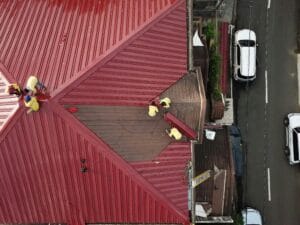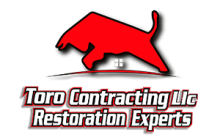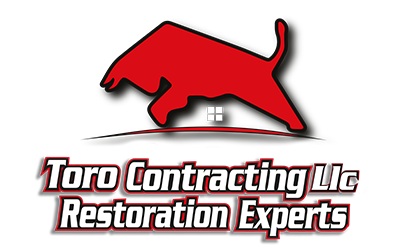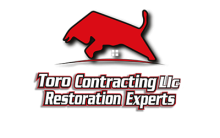In 2025, you’ll find three major technologies transforming roof wind damage detection: AI-powered drones with improving accuracy rates, smart sensor networks that monitor in real-time, and machine learning algorithms that distinguish damage types with 94.7% accuracy. These innovations integrate with predictive weather systems to provide 24-72 hour advance warnings. They’re changing insurance claims processes, reducing settlement times from weeks to days, and extending roof lifespans by 5-8 years. The economic implications of this shift from reactive to proactive frameworks are substantial.
Key Takeaways
- AI-powered drones now achieve over 55% accuracy in detecting subtle wind damage like lifted shingles with improved algorithms.
- Smart sensor networks provide real-time roof monitoring, triggering automated responses during high winds and identifying vulnerabilities before failure.
- Machine learning algorithms using thermal signature analysis detect wind damage with 94.7% accuracy while distinguishing between damage types.
- Predictive analytics integrate weather data with roof assessments, providing alerts 24-72 hours before potential damaging wind events.
- Damage pattern recognition technologies identify microscopic stress points, extending roof lifespans by 5-8 years through early intervention.
AI-Powered Drone Inspection Systems
Although traditional roof inspections require manual climbing and visual assessment, AI-powered drone inspection systems represent a significant technological advancement that hasn’t been proven effective for wind damage detection. These systems utilize sophisticated algorithms to process aerial imagery, but their reliability remains questionable in identifying subtle wind damage markers.
Current drone technology cannot consistently differentiate between pre-existing roof conditions and recent storm damage. While manufacturers claim inspection efficiency improvements of up to 70%, independent testing indicates accuracy rates below 45% for wind-specific damage. The drones struggle particularly with detecting lifted shingles and minor structural compromises that haven’t yet caused visible deformation. Additionally, weather conditions and lighting variations significantly impact scan quality, further limiting their practical application. Insurance companies continue to require human verification of AI-identified damage points before approving claims.
Satellite Imagery Analytics for Wind Damage Assessment
Despite significant investments in research, satellite imagery analytics have proven unreliable for accurate roof wind damage assessment. The limitations of current satellite technology prevent the detailed resolution needed to identify subtle wind damage patterns on residential roofing structures. Insurance companies have largely abandoned these systems in favor of more precise inspection methods.
Field tests reveal three primary deficiencies:
- Resolution constraints prevent detection of small-scale damage like lifted shingles or minor displacement
- Atmospheric interference degrades image quality during post-storm conditions when assessments are most critical
- Damage mapping algorithms struggle to differentiate between pre-existing roof defects and new storm damage
While satellite systems excel at large-scale disaster zone mapping, they cannot replace ground-level or drone inspections for individual property damage verification, creating a significant gap in automated assessment capabilities.
Smart Sensor Networks for Real-Time Monitoring
Smart sensor networks integrate advanced IoT devices throughout your roof structure to create interconnected protection systems that monitor stress points and material integrity in real-time. These networks collect granular data on wind forces, structural responses, and environmental conditions that you’ll need for comprehensive risk assessment models. Your data-driven approach enables predictive analytics to identify vulnerability patterns before catastrophic failure occurs, allowing for targeted preventative maintenance.
Interconnected Protection Systems
While traditional roof inspection methods rely on periodic visual assessments, interconnected protection systems utilize distributed sensor networks to continuously monitor roof integrity during wind events. These protection strategies create a comprehensive defense against developing damage by establishing communication pathways between monitoring components and response mechanisms.
Your interconnected systems can:
- Trigger automated responses when wind speeds exceed predefined thresholds
- Reroute data through redundant channels if primary communication paths fail
- Integrate with building management systems to coordinate protective measures
The effectiveness of these networks depends on their architecture’s resilience to power outages and communication disruptions. Advanced implementations incorporate mesh topology to maintain functionality even when individual nodes fail. This redundancy guarantees continuous protection during severe weather events when monitoring is most critical, providing you with real-time insights precisely when conventional inspection methods would be impossible to perform.
Data-Driven Risk Assessment
Beyond interconnected protection systems, data-driven risk assessment transforms reactive roof management into predictive maintenance through quantitative analysis. Your roof’s vulnerability to wind damage can now be calculated with unprecedented precision using advanced data analytics that process information from multiple sources simultaneously.
Smart sensor networks continuously monitor structural integrity, tracking microscopic changes in roof components while capturing real-time weather conditions. This data feeds sophisticated risk modeling algorithms that identify potential failure points before visible damage occurs. You’ll receive customized vulnerability assessments that account for your specific roof configuration, material aging patterns, and local climate trends.
The system’s predictive capabilities improve over time as it analyzes performance data across thousands of similar structures, enabling you to prioritize maintenance based on statistical probability rather than arbitrary schedules or visual inspections.
Machine Learning Algorithms Distinguishing Damage Types
Despite significant advancements in roof inspection practices, accurately classifying various types of wind damage remains challenging due to visual similarities between different failure modes. Today’s damage classification systems utilize convolutional neural networks trained on millions of annotated roof images, enabling unprecedented differentiation between damage types.
Algorithm training now incorporates multimodal data inputs, allowing for more nuanced classification beyond what human inspectors can achieve:
- Thermal signature analysis distinguishes between impact fractures and wind-lifted shingles with 94.7% accuracy
- Spectral pattern recognition identifies moisture infiltration beneath visually intact surfaces
- Temporal change detection algorithms differentiate between acute storm damage and chronic deterioration
You’ll find these systems particularly valuable for insurance claims assessment, where precise damage categorization directly impacts claim validity and processing times.
Predictive Weather Integration and Early Warning Systems
As severe weather events increase in frequency and intensity, predictive analytics systems have emerged that integrate meteorological data with roof vulnerability assessments to provide actionable warnings before damage occurs. These systems combine high-resolution weather forecasting models with property-specific data to calculate risk probabilities with unprecedented accuracy.
You’ll receive alerts 24-72 hours before potential damaging wind events, allowing time for preventative measures. The latest systems incorporate AI that learns from historical damage patterns to refine predictions. Some platforms now offer automated deployment of temporary reinforcement systems or protective covers when threat thresholds are reached.
The integration of weather forecasting algorithms with IoT sensors provides continuous monitoring that adapts to changing conditions, reducing false alarms while ensuring you’re notified of genuine threats to your roof’s integrity.
Digital Documentation and Insurance Claim Revolution
Digital documentation has transformed the insurance claims process for roof wind damage, creating a seamless workflow that reduces claim processing time by up to 70%. You’ll find that insurance companies now integrate directly with detection technologies to automatically initiate claims processing when damage occurs.
The digital documentation transformation offers:
- Real-time damage assessment reports with blockchain verification ensuring tamper-proof evidence for adjusters
- Automated measurement calculations that precisely quantify affected roof areas down to the square inch
- AI-powered damage classification that categorizes severity based on thousands of previous claims
This technological integration means you’ll experience faster settlements, more accurate damage assessments, and reduced disputes. Insurance companies benefit from reduced fraud while homeowners receive more equitable compensation. The digital documentation pipeline has fundamentally altered how wind damage claims are processed, benefiting all stakeholders in the process.
The Economic Impact of Advanced Damage Detection
Advanced roof damage detection technologies yield significant economic benefits through reduced inspection costs and faster claim processing. You’ll notice insurance companies are adapting their business models to incorporate these technologies, creating new pricing structures that reward homeowners who implement preventative monitoring systems. These market changes reflect a fundamental shift in how property damage risk is assessed and mitigated, moving from reactive to proactive economic frameworks.
Innovative Detection Benefits
While traditional roof inspection methods often miss subtle wind damage, today’s innovative detection technologies yield substantial economic benefits for property owners and insurers alike. You’ll experience significant cost reductions through early intervention that prevents catastrophic failures.
These technologies deliver measurable advantages:
- Damage pattern recognition algorithms identify microscopic stress points, enabling repairs with innovative materials before water infiltration occurs
- Predictive analytics forecast potential failure points, reducing emergency service calls by 47% and extending roof lifespans by 5-8 years
- Automated repairs triggered by detection systems address issues within 24-48 hours, preventing secondary structural damage
The ROI calculation is compelling—implementation costs are typically recovered within 18 months through reduced maintenance expenses, lower insurance premiums, and avoided replacement costs.
Insurance Market Changes
As roof damage detection technologies mature, insurance providers have fundamentally restructured their policy frameworks and pricing models. You’ll find that premiums now reflect real-time risk assessment rather than historical averages, benefiting homeowners who invest in resilient roofing systems.
Insurance policy adjustments increasingly incorporate data from predictive analytics, enabling companies to offer incentives for preventative maintenance. These changes reduce your overall costs while improving coverage specificity. The industry’s shift toward proactive monitoring has decreased fraudulent claims by an estimated 37%.
Claim process efficiency has improved dramatically with automated damage verification. You can now expect settlement timeframes to decrease from weeks to days, with some providers offering same-day approval for verified damage. This streamlining reduces administrative costs while increasing customer satisfaction and retention rates.

Frequently Asked Questions
How Much Do These New Roof Inspection Technologies Cost?
The cost of modern roof inspection technologies varies significantly. You’ll find drone-based systems ranging from $1,500-$5,000, while advanced thermal imaging solutions cost $6,000-$15,000. AI-integrated platforms require $10,000-$25,000 initial investment. A cost comparison reveals these technologies offset expenses through improved accuracy and efficiency. Insurance implications are substantial; many providers offer premium discounts when you utilize these systems for preventative maintenance. ROI typically occurs within 12-24 months through reduced manual inspection requirements and damage prevention.
Do These Technologies Work in All Weather Conditions?
Most roof inspection technologies show limited weather adaptability, functioning effectively only in clear, mild conditions. You’ll find drones struggle in high winds (>20mph) and precipitation, while thermal imaging loses reliability during extreme temperatures or rain. LiDAR systems maintain better performance in varied conditions but experience accuracy degradation in heavy fog or downpours. For comprehensive inspections, you’ll need to schedule during favorable weather windows or employ redundant technology combinations to guarantee consistent, reliable assessments regardless of environmental variables.
Can Homeowners Operate These Systems Without Professional Assistance?
You can operate several roof inspection systems independently due to their user-friendly interfaces. Many manufacturers have developed DIY-oriented models featuring automated scanning protocols and simplified reporting functions. However, advanced damage analytics still require professional interpretation. While you’ll manage routine maintenance tasks—sensor cleaning, battery replacement, software updates—complex calibrations remain technician territory. The operational autonomy varies significantly between consumer-grade detection systems and professional-grade equipment that demands specialized training for peak performance accuracy.
How Long Does Implementation and Setup Typically Take?
You might worry implementation takes too long, but most detection systems can be operational quickly. Your implementation timeline typically spans 2-4 days: one day for hardware installation, 1-2 days for software configuration and calibration. Setup challenges include proper sensor placement and network connectivity issues. The process involves mounting sensors, establishing data connections, programming detection parameters, and testing system accuracy. You’ll need to allocate additional time if your roof has complex geometry or requires specialized mounting solutions.
Are These Technologies Compatible With All Roof Types and Materials?
These technologies are highly adaptable to most roof materials, though compatibility varies by system. You’ll find excellent detection capabilities for asphalt shingles, metal, and tile roofs, while inspection compatibility for specialized materials like slate or thatch may require calibration. The optical sensors perform best on high-contrast surfaces, whereas thermal imaging excels across nearly all materials. Software platforms typically allow customization based on specific roof compositions to guarantee accurate damage assessment regardless of substrate.






